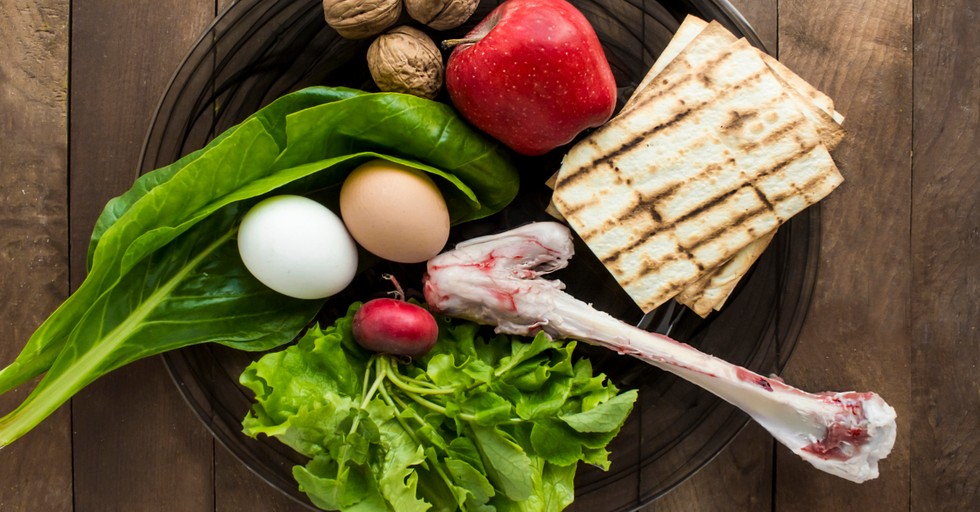10 Things Christians Should Know about Passover
- Dawn Klinge Crosswalk.com Contributing Writer
- Updated Apr 23, 2024

The most famous Passover meal is best known as The Lord’s Supper. This Seder meal marked the last time Jesus ate with his disciples before his arrest and crucifixion. Observed for over 4,000 years, Passover is the oldest known religious ritual in Western history. While Passover is a part of Jewish cultural and faith traditions, it has relevance for Christians as well.
Why does Passover matter to Christians? The Passover story is about redemption and freedom, themes that are echoed throughout the Gospel message. It’s a foreshadowing of the hope that Christians find in Jesus and it points to the continued hope that we look forward to upon His return.
Passover contains invitations that speak to Christians today. It’s a celebration and a remembrance of our roots, and it’s a story about God and how He loves His people. There’s deep wisdom and profound truths to be found within the traditions of Passover. The following are ten things about Passover that Christians should know.
Get your FREE Easter Guide here. Have encouragement delivered straight to your inbox!
Photo credit: ©Getty Images/Gulsen Ozcan
-
![chains breaking, what does passover celebrate]()
1. It Reminds Us that We were Once Slaves Who are Now Free
Slide 1 of 10Passover began with Moses, under the instruction of God. He told the Israelites exactly what to do on that night, protecting them from the final plague that came across Egypt. It was through this plague, the death of every firstborn in Egypt, that Pharaoh finally changed his mind (temporarily) and allowed the Israelites to leave after 400 years of slavery.
Though he was an Israelite himself, Moses had grown up in the palace of Pharaoh. He left that life behind after seeing the injustices inflicted upon his people by the Egyptians. When Moses was a baby, Pharaoh had decided that there were too many Israelites, so he ordered the death of every male child born to Hebrew women. Moses’ mother hid him as long as she could before placing him in a basket that floated down the Nile River. Under God’s divine providence, Pharaoh’s daughter found the baby and decided to raise him herself. She unknowingly hired Moses’ own mother to come to the palace as a nursemaid to take care of her baby.
The book of Exodus tells the story of how God used Moses to lead the Israelites out of Egypt to freedom. This story is a foreshadowing of how Jesus left Heaven to come to Earth, fully human and fully God, and how He showed mankind the way out of slavery and into the freedom that is available through faith in Him.
Photo credit: ©Getty Images/manopjk
-
![passover meal, what does passover celebrate]()
2. Its Rituals Keep the Experience Alive in Our Hearts and Minds
Slide 2 of 10Passover is an annual reliving of the Exodus journey. Jesus celebrated Passover with his family as a child, and later with his disciples. In these days, this was an event that brought the Jewish people to the Temple in Jerusalem. The Temple was built on Mount Moriah, the same mountain that Abraham had taken Isaac to and prepared him as a sacrifice to God.
The Temple was where people brought their sacrifices to offer to God. After it was destroyed in 70 A.D. the observance of Passover became something that people celebrated primarily in their homes. This brought about a shift in thinking. For a thousand years, the Temple was the place the people went to feel God’s presence, but its destruction did not mean God’s destruction. God is everywhere, and His presence can be found and experienced together.
As Christians, we also find significance in the truth that Jesus was the final and perfect sacrifice; the lamb that was slain. God offered His Son in our place.
When people observe the Passover Seder in their homes, it’s more than a feast. It’s a reenactment of a divinely ordained journey from slavery to freedom. The rituals of Passover hold holy significance. Keeping memories alive is essential to faith. The communal aspect of this meal brings different people together, and God is present among his people. Our homes become miniature temples and we become a “kingdom of priests” (Exodus 19:6).
Photo credit: ©Getty Images/pushlama
-
![Lamb in the field, what does passover celebrate]()
3. It Required That an Unblemished Lamb be Sacrificed
Slide 3 of 10At the first Passover, God instructed the Israelites to slaughter a one-year-old male lamb that had no defects. They were to make sure that no bones were broken in the process. The head of the household was to apply some of the blood to the tops and sides of the door frame of the house. The lamb was roasted and eaten, but the people were instructed to eat it in a way that signified they were ready to travel (Exodus 12:7-8).
Following these instructions protected the Israelites from the final plague that struck Egypt that night, killing the firstborn in every household. After that first Passover, God’s people were instructed to mark the occasion with an annual feast as an observance of what God has done for them.
Christ was crucified during Passover—and not a single bone was broken. He is the Lamb without blemish and it is His blood that covers us, saving us from the death that sin brings.
Photo credit: ©iStock/Getty Images Plus/Filip_Krstic
-
![Leavened bread and wine, what does passover celebrate]()
4. Eating Unleavened Bread is Significant
Slide 4 of 10Another important ritual involved in Passover is the eating of matzah (unleavened bread). In Biblical times, the Festival of Matzah was a week-long remembrance that began after the Passover meal. After the final plague, the Israelites did not have time to bake bread that rose; they had to gather their things and leave in a hurry.
After the destruction of the Temple, the Festival of Matzah was incorporated into the Seder meal as Jews began observing Passover at home. Jewish tradition forbids eating any unleavened bread during the seven days of Passover. It can serve as a reminder of two things: to watch over our egos and keep them from becoming “puffed up”, as well as the idea that we depend not on bread, but on God.
Leaven (yeast) is often compared to sin in the Bible. A little bit of leaven in the dough will eventually affect the whole loaf. In preparation for Passover, the careful removal of all leaven can take on a deep meaning for Christians when we think about how sin affects our lives.
Photo credit: ©iStock/Getty Images Plus/gorchittza2012
-
![Wheat, what does passover celebrate]()
5. An Omer of Wheat was Brought to the Temple 50 Days after the Feast
Slide 5 of 10Not directly related to the original Exodus, but important nonetheless, a third aspect of Passover took on significance during the time the Temple stood: Jewish people saw Passover as a time to celebrate agriculture and harvest. On the second day of Passover, farmers would cut down the first sheaf of the barley harvest. An omer is a measure of this grain. For the next fifty days, farmers would harvest and count their grain. On the final day, they would bring the wheat offering, an omer, to the Temple in Jerusalem. This is the day Christians know as Pentecost.
There were fifty days between when the Israelites left Egypt and when Moses was given the Law at Mt. Sinai. Though the practice of grain offering ended after the destruction of the Temple, the tradition changed as Jews began to mark the days by reading sacred texts, saying a blessing, and stating which of the fifty days it was. We can all learn from this practice of making each day count.
Additionally, Christians can remember Pentecost as the day when the Holy Spirit came to Christ’s followers who were hiding in the upper room, giving them the power to speak and proclaim the Gospel of Jesus. On that day, thousands listened to Peter preach and came to believe in Christ. This is often looked upon as the beginning of the Church.
Photo Credit: ©iStock/Getty Images Plus/Maksym Belchenko
-
![back view of young woman reading Bible outdoors, what does passover celebrate]()
6. Preparation for Passover is Essential
Slide 6 of 10Preparation for Passover typically begins about 30 days before. The Jewish holiday of Purim, much like Shrove Tuesday, is a time of celebration that marks the beginning of the preparation period; in fact, many believe that the tradition of “spring cleaning” comes from Passover preparations. The house must be thoroughly cleaned so that every bit of leaven can be removed.
This preparation also involves studying and giving to charity. Its biblical origins go back to the fact that people needed to find the appropriate lamb and prepare for travel to the Temple.
Refraining from eating bread for eight days, which is the tradition now, is a form of fasting that Christians can relate to. It’s an acknowledgment that we can survive without bread, but not without God.
Photo credit: ©Unsplash/Priscilla-du-preez
-
![Cute happy married couple in kitchen cooking, what does passover celebrate]()
7. Charity is a Part of Observing Passover
Slide 7 of 10Sometime around the Middle Ages, it became customary in the Jewish community to set aside money into special funds that were specifically designated to purchase foods for families that could not afford to otherwise—foods that could be eaten during Passover. Likewise, hospitality is encouraged.
Rich and poor alike are invited to participate in the community experience of Passover feast. Like the freedom that was granted to the Israelites upon the very first Passover, it was not limited to a few, but it was a shared experience for all of the Jewish people.
Sharing a meal together is something that brings unity and bridges cultural and economic divides. It can be a sacred experience.
Photo credit: ©GettyImages/simonapilolla
-
![8. The Components of the Sedar Plate Each Have a Meaning]()
8. The Components of the Sedar Plate Each Have a Meaning
Slide 8 of 10Here’s what you’ll find on the Seder plate during the Passover feast: matzah (bread of affliction), a roasted shank bone (represents the sacrificial lamb), a vegetable to dip in salt water (Joseph’s coat was dipped in blood), a mixture of fruit, nuts, and spices called Charoset (similar in consistency to the mortar that was used to make bricks in Egypt), Maror, a bitter herb, usually horseradish, (the bitterness of slavery, empathy), and an egg (rebirth, first steps toward freedom).
There are other traditional foods served, too, but the ones listed above are the central ritual foods. They are often served on a special Seder plate that is only used for this meal.
Symbols matter. They connect events that happened in ancient Biblical times with the Passover meal that we have today. The past is brought into the present so that we can remember.
Photo credit: @Thinkstock/JupiterImages
-
![passover meal, what does passover celebrate]()
9. The Blessings, Questions, and Praising are as Important as the Food
Slide 9 of 10The ritual of the Seder meal is precise; it’s these rituals that separate this meal from daily life and sets it apart as sacred. Using guides called Haggadahs, people follow along with the liturgy during the meal. Haggadah means story; the Passover meal is literally a retelling of the story of the Exodus from Egypt.
There are thousands of different Haggadahs available today, but they are all similar in that they all contain the same blessings. There are even a small number of Haggadahs produced specifically for Christians.
The stories, blessings, and rituals that are practiced at Passover Seder meals have been practiced for thousands of years. It is likely that Jesus experienced traditional Passover Seder meals that were guided by these same rituals and blessings.
Photo credit: ©Getty Images/photovs
-
![woman with arms raised with clouds behind, what does passover celebrate]()
10. Passover is a Story of Freedom
Slide 10 of 10The story of Passover is a story of God’s redemption. The fourth traditional cup of wine that is served at the conclusion of the Passover meal has a declaration that accompanies it: God’s declaration of redemption.
“I will claim you for me as a people and I will be your God” (Exodus 7).
The Passover meal is a time to look back and remember what we’ve been set free from. It is also a time to look forward, and find hope in God’s promises that are still to come.
There’s a lot of common ground that Christians can find with Jewish people in the celebration of Passover.
Photo credit: © Unsplash/Mohamed Nohassi
Dawn is a writer and Christian blogger who loves encouraging people to keep their focus on Jesus. She’s the author of Look to Jesus: How to Let Go of Worry and Trust God. She’s a wife and mom to two teens. A Seattle girl, she loves books, coffee, and spinning classes. You can find her at Above the Waves. Facebook. Instagram. Twitter.



 Previous
Previous








